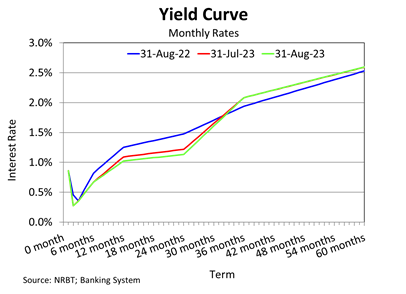Highest credit growth since 2008
- Details
- Category: Economic Release
- Created: 15 January 2016
| Banking Sector Developments September 2015 |
||||
| Sep 15 | Aug 15 | Jul 15 | Jun 15 | |
| Deposit rate (%) * |
2.29 | 2.27 | 2.28 | 2.35 |
| Lending rate (%) * |
8.27 | 8.26 | 8.22 | 8.23 |
| Total Deposits (T$m) |
403.9 | 399.8 | 388.8 | 379.6 |
| Total Lending (T$m) | 427.9 | 422.4 | 418.1 | 416.2 |
| New commitments (T$m) | 13.5 | 10.5 | 14.5 | 14.1 |
| Broad Money (T$m) | 422.3 | 424.2 | 413.5 | 403.3 |
| * Weighted Average calculated as a function of interest rate and volume of deposits and loans | ||||
Highest credit growth since 2008
Lending
Total bank lending rose over the month by 1.8%, reaching its highest annual credit growth rate of 14% since 2008. This is due to rises in all the lending categories, with household loans increasing the fastest. A decline in all lending rate categories supported the increase in lending over the year.
Business lending
Banks’ lending to businesses increased over the month by 2% to $153.3 million. This is due mainly to an increase in lending to the construction, distribution and agricultural sectors. New business loan commitments from banks increased significantly over the month by $2.8 million, reflecting the increases in construction and distribution loans. Some of these loans were funded from the government managed funds scheme. Including government on-lent loans, total lending to businesses rose by 1.5% over the month. In year ended terms, banks’ lending to businesses increased by 15.8%. Majority of these loans were for manufacturing, trade, construction, agricultural and tourism activities. Including government on-lent loans, lending to businesses only rose by 11.9% over the year due to decline in government on-lent loans.
Household lending
Banks’ lending to households rose over the month by 1.6% to $160.7 million, underpinned by increases in housing and personal loans. These increases in housing and personal loans indicate rises in construction and consumption activities. Including lending through the non-bank financial institutions credit growth also increased over the month by 1.6%, indicating increases in household activities. In year ended terms, banks’ lending to households increased by 13.5%, reflecting rises in housing and personal loans. Including lending offered by the non-bank financial institutions, lending to household recorded an annual credit growth of 16.5%. Declines in lending rates on housing and other personal loans supported the rise in household lending.
Other lending
Other loans increased over the month by 2.6% but declined by 54.1% over the year, due mainly to lending activities within the non-profit institutional sector.
Non-performing loans
Total non-performing loans for the banking system declined over the month of September by 4.3% to $25.8 million, which represents 8.2% of total loans. This reflected improvement in non-performing business loans. Over the year, total non-performing loans also fell by 20.4%, underpinned by a 16.0% decline in non-performing household loans which offset a 4.3% increase in non-performing business loans.
Deposits
Total bank deposits increased over the month by 1.1% to $403.9 million which resulted from increases in all the deposits categories. Demand deposits grew the fastest, underpinned mainly by an increase in deposits made by households. Over the year, total bank deposits grew by 11.9%, due to increases in all the deposit categories particularly demand deposits by businesses.
Interest rates spread
Weighted average interest rate spread slightly fell over the month from 5.99% to 5.98% in September 2015. Weighted average lending rate rose by 1.1 basis points to 8.27% whilst weighted deposit rate increased by 1.3 basis points to 2.29%. Over the year, weighted average interest rate spread narrowed by 32.5 basis points, driven by a 31.1 basis points decline in weighted average lending rate. The decline in weighted average lending rate resulted mainly from an increase in low interest rate loans to businesses.
Broad money
Broad money fell slightly over the month by 0.4% to $422.3 million, due to a 0.8% decline in net foreign assets, offsetting a 0.2% increase in net domestic assets. The decline in net foreign assets resulted from a fall in deposits abroad while an increase in domestic credit drove the growth in net domestic assets. Currency in circulation also fell over the month due to recall of old currencies. However, broad money rose by 13.2% over the year, driven by increases in foreign reserves and domestic credit. Total domestic demand deposits and currency in circulation also increased over the same period.
Liquidity
Banking system liquidity declined slightly over the month to $167.2 million but still remain at a high level. However, banking system liquidity increased over the year by 13.2%, due to increases in deposits and the foreign reserves.
Outlook
Credit growth is supported by the continuous improvements in business confidence, improving economic conditions and annual events. Continued competition amongst banks and the ongoing lending activities of the Government’s managed funds will continue to support the current low lending rates. The NRBT is forecasting credit growth to grow by more than 10% in the next six months. The NRBT will continue to promote prudent lending and closely monitor credit growth in light of the impact on the monetary policy targets and financial stability.
Download the Banking Sector Development report of May for more information and figures.

